

PWTT

What is PWTT?
PWTT can detect sudden blood pressure change and trigger NIBP measurement to confirm it. Together with periodic NIBP measurement, this can provide more complete blood pressure monitoring. PWTT, pulse wave transit time, is a non-invasive parameter which can indicate sudden change in blood pressure. PWTT is measured by continuous monitoring of ECG and pulse wave. No additional sensors or modules are required. In most cases, change in PWTT correlates with change in blood pressure. When PWTT change exceeds a threshold, it triggers NIBP measurement to confirm blood pressure.
PWTT detects sudden change in blood pressure
Periodic NIBP measurement is only measured at specified times so sudden critical blood pressure changes that occur between the periodic measurements may be missed until the next periodic measurement.
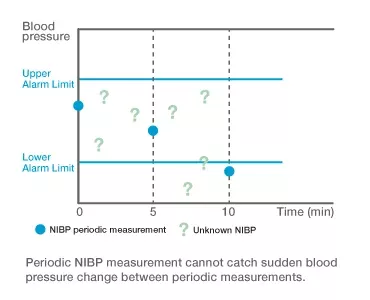
Conventional Periodic NIBP Measurement
With PWTT, if sudden blood pressure change occurs between periodic NIBP measurements, PWTT detects it and triggers an NIBP measurement to confirm it.
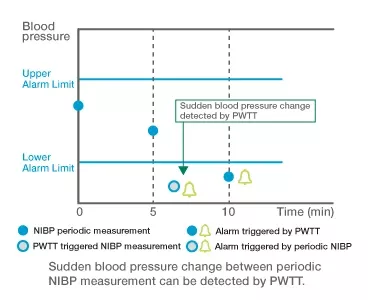
PWTT triggered NIBP Measurement
PWTT has a correlation with blood pressure in most cases. However it cannot catch all instances of blood pressure change. Refer to the Measurement Cautions and Limitations section at the bottom of this page. With recognition of these limitations, PWTT can be a valuable enhancement to non-invasive blood pressure monitoring.
Principle of PWTT
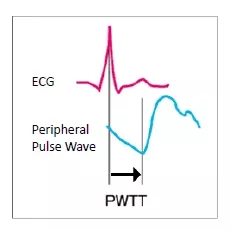
| Blood pressure | PWTT |
|---|---|
| Increases | Shortens |
| Decreases | Lengthens |
PWTT is the time from the R wave of the ECG to the appearance of the peripheral pulse wave. The peripheral pulse wave uses a photoplethysmographic signal obtained from a SpO2 probe attached to a finger. Generally, the PWTT shortens as blood pressure increases and lengthens as blood pressure decreases.*
Why does PWTT reflect changes in blood pressure?
The speed of waves that propagate through a tube depends on the stiffness of the tube; the stiffer the tube, the faster the waves propagate, and the softer the tube, the slower the waves propagate (Figure 2).
In the human body, the arterial wall becomes stiffer when blood pressure increases, which speeds up the propagation of the pulse wave and accelerates the time it takes for the pulse wave to reach the peripheral arteries.
When blood pressure decreases, the arterial wall becomes softer, and the pulse wave travels slower to the peripheral arteries. Thus, changes in blood pressure result in changes in the time it takes for the pulse wave to travel through the blood vessels. Therefore, when a change in PWTT is observed, there is also a change in blood pressure.*
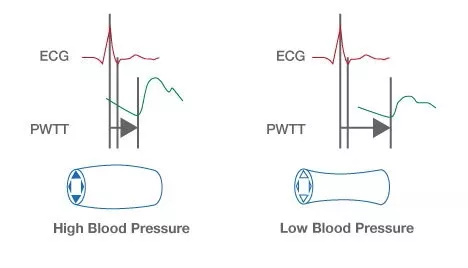
References
1) Sugo Y, Ogino K, Ochiai R, Iwao Y,. Evaluation of blood pressure monitoring using pulse wave transit time in the operating room (in Japanese). The Japanese journal of medical instrumentation. 2001; 71 (10),551-552
2) Sugo Y, Ogino K, Mato T, Uehara J, Tsutsumi H. Blood pressure monitoring in the emergency room using pulse wave transit time. The Japanese journal of medical instrumentation. 2002; 72 (10), 551-552
Case Studies
These examples show some clinical applications of PWTT, as well as typical correlation of PWTT with blood pressure. The data is from actual cases. IBP, PWTT and periodic NIBP were actually measured but the PWTT triggered NIBP is a simulation based on the actual measured data.
OR
In this case, bleeding started shortly before a periodic NIBP measurement. The resulting BP drop was not detected by the periodic NIBP measurement, but PWTT immediately detected the BP change. Ephedrin was given to increase the BP.
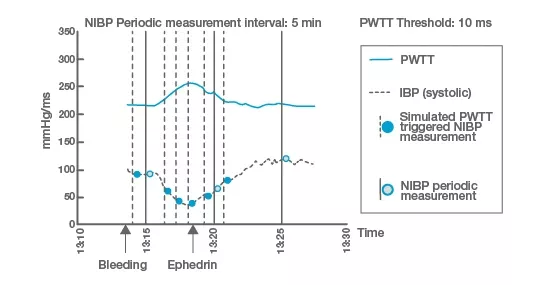
ICU
In this case, the BP of a conscious patient in the ICU was high and unstable. A sedative was administered and the BP dropped then became stable. 30 minute periodic NIBP measurement could not detect these BP changes but PWTT was able to detect it.
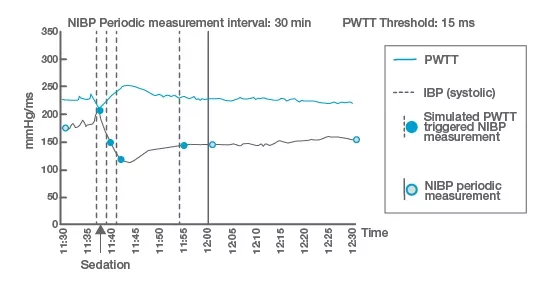
Reference
Sugo Y. From invasive blood pressure measurement to real time measurement ~PWTT (Pulse Wave Transit Time) triggered NIBP measurement~. The 3rd Workshop of the Japanese Society for Medical and Biological Engineering CE Safety Study Group. 2001.
Measurement Cautions and Limitations
- Do not measure NIBP with PWTT on a neonate because circulatory kinetics of a neonate change rapidly.
- In the following cases, PWTT triggered NIBP measurement may trigger too often or fail to trigger.
- Rapid blood pressure change due to vasoactive drugs, such as phenylephrine and nicardipine
- Unstable pulse wave due to poor peripheral circulation
- Too many arrhythmias
- Patient movement or change of body position
- Noise on ECG due to ESU
- SpO2 measurement on foot of pediatric
- Do not decrease the frequency of periodic NIBP measurement when using PWTT. Set the frequency of periodic NIBP measurement to the normal setting you would use if you were not using PWTT.





